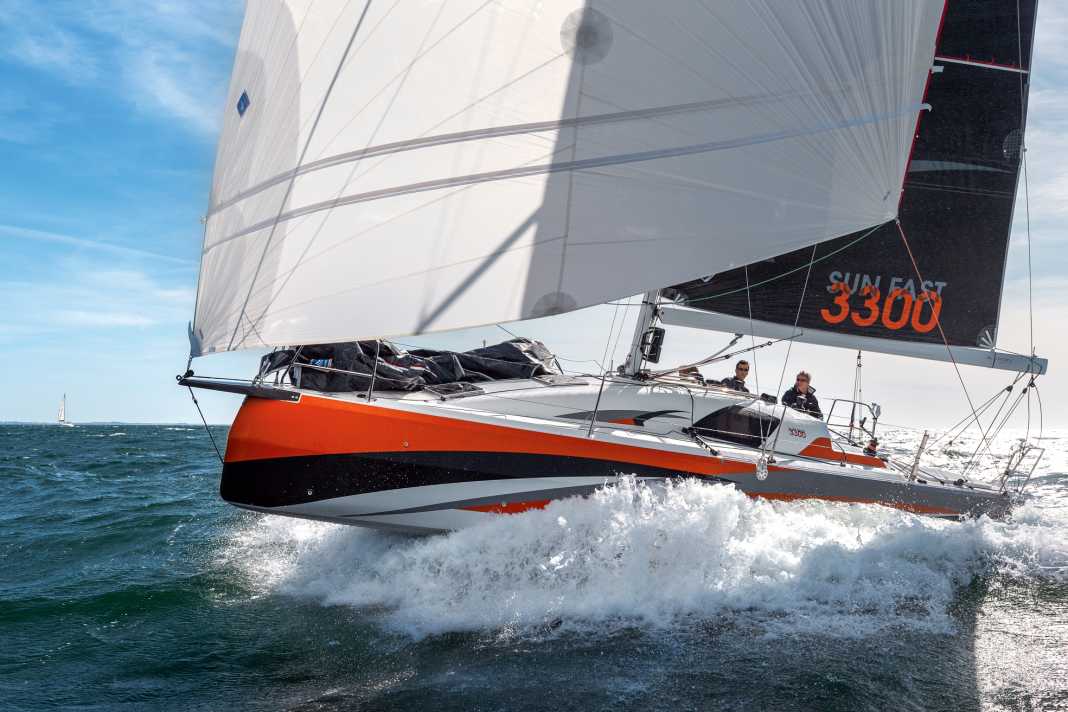





The topic is gaining more and more momentum: Single-handed and double-handed regatta events on long or medium distances, across the high seas or along the coast. In France, the motherland of offshore sailing, the trend sometimes mobilises whole armies of regatta athletes. And not just well-known professionals, but increasingly also ambitious and adventurous recreational sailors. The best example of this is the Transquadra. Only amateurs over the age of 40 are allowed to take part in the extremely popular single-handed and double-handed race across the Atlantic on regulated production boats. And the number of participants skyrockets with every event.
However, the single and double-handed sailing scene is also enjoying remarkable growth in the Baltic region. This is not least due to the successful regatta events on the Baltic Sea, such as the Silverrudder (single-handed only) or the Vegvisir Race (single and double-handed), where the starting places are fully booked just a few hours after the registration centres open. And what's more: offshore sailing was to become an Olympic discipline. It was planned that mixed teams of two would compete for the first time at the 2024 Summer Games in Paris on regatta yachts suitable for offshore sailing. After a long tug-of-war, the end of mixed offshore was announced in 2021, but the decision had little impact on the popularity of two-handed sailing.
This popular trend is also being fuelled by attractive yachts specially designed for this purpose. The market for ocean-going performance cruisers in the mid-length segment is growing rapidly. The J/99 should be mentioned here, a variant of which is also very suitable for longer courses with a small crew, as well as the Dehler 30 One design.
The competition: attractive, ocean-going performance cruisers
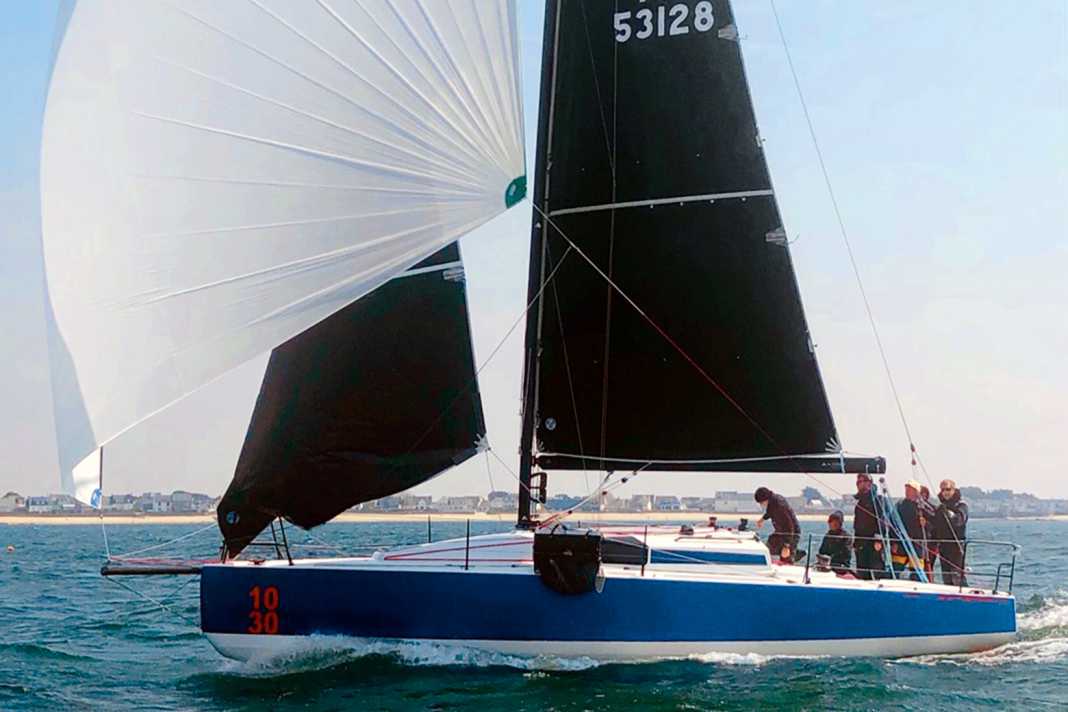




Breaking with convention
In 2019, the Jeanneau racer came second in the IRC Double classification at the Spi Ouest, the spring regatta classic off La Trinité-sur-Mer on the coast of Brittany. This exceeded even the boldest of expectations, both those of the shipyard and those of the scene connoisseurs. The designers Daniel Andrieu and Guillaume Verdier are jointly responsible for the revolutionary shapes of the Sun Fast 3300. Several unusual design features are striking, in particular the strikingly voluminous, almost bulbous bow. The shape is familiar from the spectacular Imoca 60 class ocean racers and the latest developments in the Mini 6.50. The fat front is primarily intended to compensate for the buoyancy and high dimensional stability produced by the wide stern section. The aim of the design is to achieve the most balanced swimming position possible, even when heeling, without the bow diving forwards too much.
The second obvious innovation is the so-called tumblehome hull shape. This means that the hull is wider than the deck. In the case of the Sun Fast 3300, the freeboard is visibly kinked halfway up and is drawn in towards the deck - by around ten centimetres on each side. This allows Jeanneau to save material and, above all, weight during construction, which shifts the centre of gravity downwards. That is the goal. The disadvantages: Care must be taken when mooring in the box to avoid damaging the hull, which protrudes to the side. And: The shell must be built in two halves, otherwise it cannot be demoulded.
The most revolutionary development of the Sun Fast 3300, however, is probably not even visible in the water. Below the waterline, the hull lines in front of and behind the keel are inverted, i.e. concave.
Water ballast instead of crew
The Sun Fast 3300 is built entirely by Delphia Yachts in Poland. Since July last year, the shipyard in Olecko has been producing under the umbrella of the mighty Beneteau Group, which also includes Jeanneau. The hull and deck are built there using the weight-saving vacuum infusion process as a sandwich construction with a balsa wood and foam core. The solidly built floor assembly is also produced using infusion and subsequently glued into the hull.
If you wish, you can have your Sun Fast 3300 equipped with additional water ballast tanks for long offshore trips and small crews. Around 200 litres of seawater provide additional righting moment instead of live ballast, also known internationally as "rail meat". The tanks are each refuelled and emptied again using two separate pumps. However, the processes still take time. On the test ship, the tank was filled upwind in a long 1:40 minutes and only completely emptied again after 1:30 minutes. The shipyard now wants to try to speed up the processes with more powerful pumps and thicker hoses.
Foils contradict the concept of the Sun Fast 3300
Foils, on the other hand, such as on Beneteau's one-design racer Figaro 3, were never really an issue for the Sun Fast 3300 project. According to Jeanneau product developer Hervé Piveteau, the necessary structural reinforcements in the hull were far too heavy for the additional performance that the foils would ultimately bring. Furthermore, foils would have a negative impact on the IRC and ORC measurements and are not even permitted for many long-distance classics, such as the Transquadra.
On the Sun Fast 3300, the rig is positioned conspicuously far aft. Due to the unusual volume distribution of the hull, the IRC fin keel has to be flanged relatively far aft under the boat, approximately in the centre of the entire length. This also means that the sail pressure point has to be lower. And because the mast on deck cannot be positioned directly in front of the companionway, the rig is trimmed from the shipyard with an obvious amount of mast drop, which at least looks rather strange. The bowsprit with water stay can be ordered in different lengths, depending on use and dimensions. The Sun Fast 3300 can also be optionally equipped with a conventional symmetrical spinnaker, for example for upwind and downwind racing.
As if on rails
The conditions could not have been better for the YACHT test in Brittany: 15 to 20 knots of wind, plus a long wave that you can really ride with a fast boat like the Sun Fast 3300, and sunshine to boot. With her full bow and flat underwater hull, the boat planes easily and quickly. In the crisp gusts, 15 knots of speed are soon on the log, and that's only with the relatively small and flat A5 gennaker, which is mainly used on long offshore trips.
Steering the boat with a gennaker in these conditions is simply fantastic. The two rudder blades offer unrestricted control at all times. Even with a sudden increase in pressure in the heaviest gusts, the Jeanneau remains controllable, even without much effort on the tiller. This makes it easy not only for the helmsman, but also for the autopilot over long distances.
However, the fun factor is significantly reduced on the crosswind leg. The bulging bow doesn't really cope well with the approaching waves and the boat usually sets in unpleasantly hard. This can be annoying on long strokes. Cruising in wind and waves does not seem to be the Sun Fast 3300's favourite discipline. Nevertheless, her potential is surprising: the Frenchwoman reaches 6.7 knots on a sailed angle of 40 degrees to the true wind. The values recorded are impressive.
Long strokes with a small crew: the trend is obvious
The layout in the cockpit of the Sun Fast 3300 is designed specifically and exclusively for use with a small crew. This means that the mainsheet with coarse and fine adjustment as well as the lines for the double-guided aft stays and for the traveller are routed directly within the helmsman's reach. But only the helmsman can work efficiently with the functions from his position; co-sailors have to contort themselves to do so. This is a compromise that Jeanneau has made in favour of the focused concept for single and double-handed sailors.
The cabin superstructure is stepped and is conspicuously indented at the front. There are good reasons for this. First and foremost, Jeanneau can save even more weight because less material has to be used for a larger deckhouse. In addition, the track for adjusting the genoa lifting points can be installed transversely at the front, which offers significant advantages for trimming the headsail, especially on courses with somewhat shrouded sheets.
And last but not least, the design allows the installation of cabin windows through which you can also see forwards from the inside and into the sails. For long-distance sailors, this means a considerable gain in comfort and efficiency.
Only the bare essentials
Sheer functionality dominates below deck on the Sun Fast 3300. Cosiness is sought in vain. Nevertheless, with two sufficiently long sofa berths and two double cabins aft, the limited touring capability for up to six people is given. A toilet and a simple washbasin can be found in the otherwise empty and unobstructed foredeck. As with the J/99, only the sails are stored here.
The two functional areas, the galley and the navigation area, are designed on both sides of the companionway in a strikingly spacious and roomy way. Bucket seats have also been installed on each side, allowing long-distance sailors to take a break from time to time. This shows where the concept places the emphasis. This is also emphasised by the complete absence of fixed storage spaces in both the saloon and the cabins.
The quality of the interior fittings is of secondary importance for a regatta boat like the Sun Fast 3300. The shipyard clearly doesn't want to make a secret of this. The inside of the hull and deck are only roughly painted over with topcoat, and electrical cables have been tacked to the walls in an unsightly manner. In addition, a few very short LED light strips only provide a dull light below deck.
Gaining a head start
With the Sun Fast, Jeanneau presents a series boat that is more consistent than almost any other and also scores with its innovative strength. The first successes on the regatta course now promise even more attention - from potential buyers as well as from a possibly duped competition.
The reversal of the hull lines
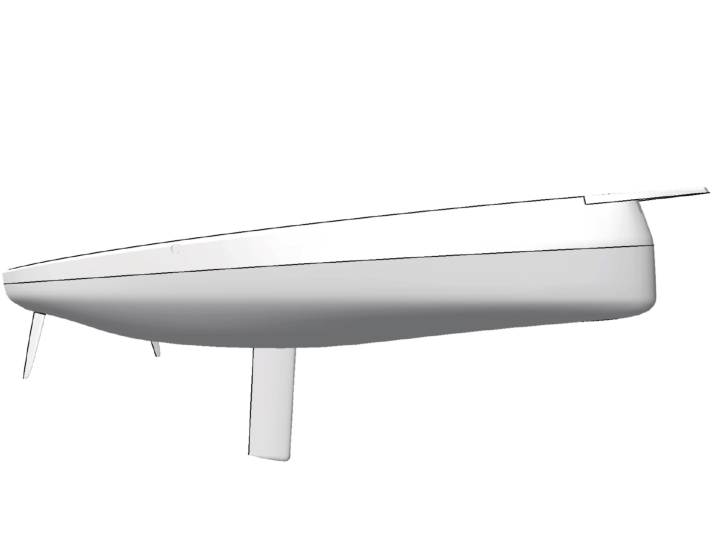
The hull of the Sun Fast 3300 is concave at the bow and stern. This means that the lines are not straight, but are inverted in a certain area, as the designers call it. The aim is to achieve the longest possible waterline and a balanced volume distribution over the entire length of the boat. What's more, the concave shapes at the rear are intended to create buoyancy with a slightly forward-facing component. This is intended to literally push the boat in the direction of travel. The idea is not entirely new and has already been introduced by designer Guillaume Verdier for the America's Cup, on Team New Zealand's AC72 catamaran for the 2013 Cup off San Francisco.
The measured values for testing the Sun Fast 3300
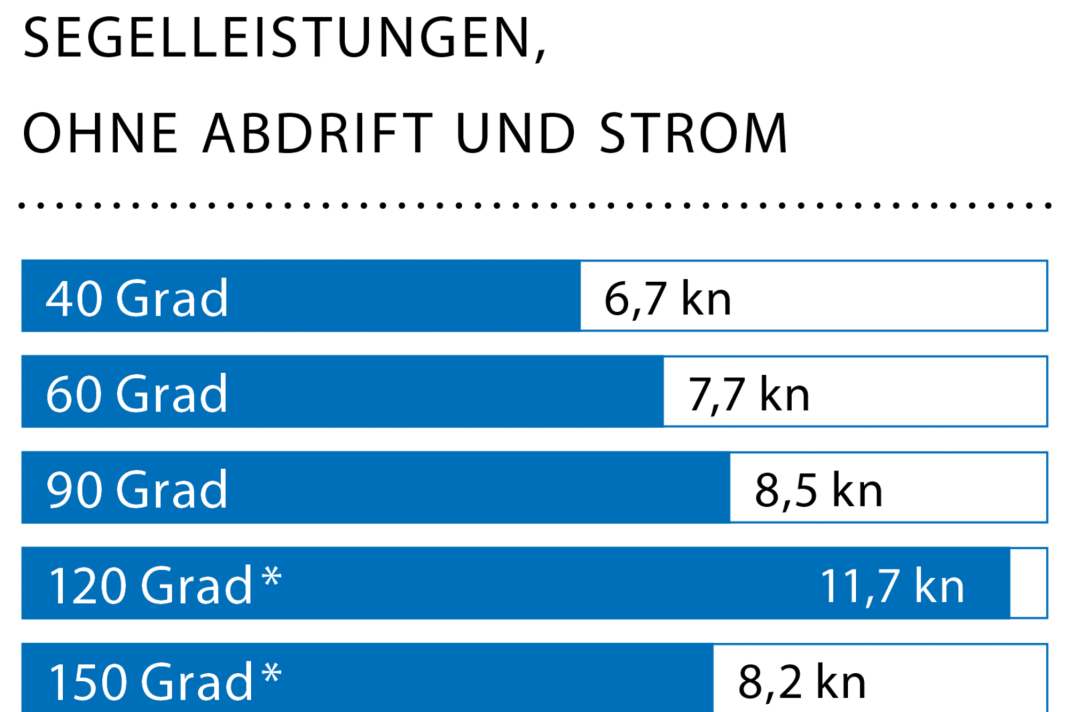



The Sun Fast 3300 in detail
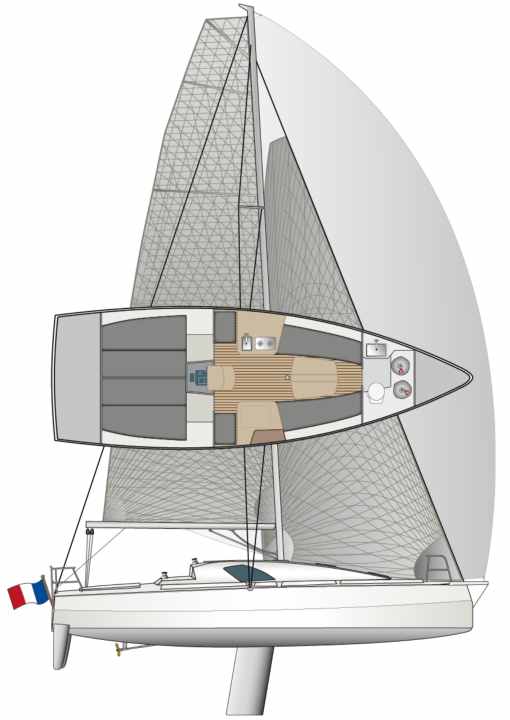
Technical data of the Sun Fast 3300
- Designer: Andrieu/Verdier
- CE design category: A
- Torso length: 9,99 m
- Width: 3,40 m
- Depth: 1,95 m
- Weight: 3,5 t
- Ballast/proportion: 1,4 t/40 %
- Mainsail: 33,0 m2
- Genoa (105 %): 27,0 m2
- machine (Yanmar): 10 kW/14 hp
Hull and deck construction
GRP sandwich with balsa wood core, built using the vacuum infusion process. Floor assembly glued in
Price and shipyard
- Base price ex shipyard: 182,900 € gross incl. VAT without sails
- Guarantee/against osmosis: 2/5 years
As of 04/2024, how the prices shown are defined can be found here!
Shipyard
Chantiers Jeanneau, 85500 Les Herbiers (FRA); www.jeanneau.de
Distribution
Dealer network
YACHT review of the Sun Fast 3300
Innovative and attractive series racer from Jeanneau for uncompromising use in single and double-handed regattas over longer distances. Many exciting new design features
Design and concept
- + Uncompromising alignment
- + Very innovative design
- + Competitive base price
Sailing performance and trim
- + High performance potential
- + Single-handed cockpit layout
- - Hard insertion into the waves
Living and finishing quality
- + Purpose-designed interior fittings
- - Unsightly finishes in detail
Equipment and technology
- + High-quality equipment standard
- + Perfect layout of the fittings
- + Perfectly tuned control system
A video of the Sun Fast 3300
The article first appeared in YACHT 12/2019 and has been updated for the online version.

